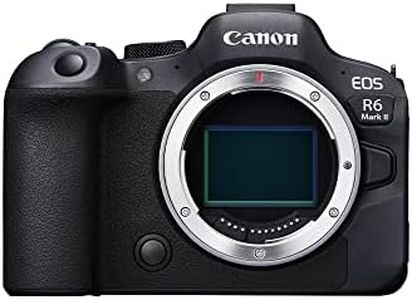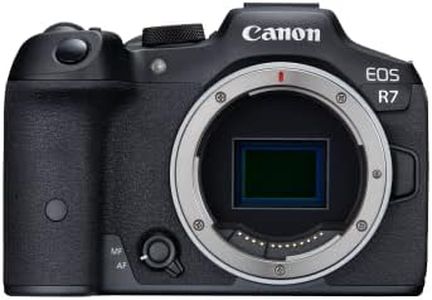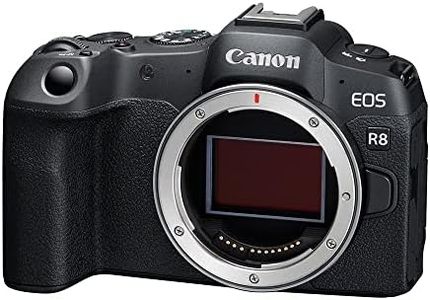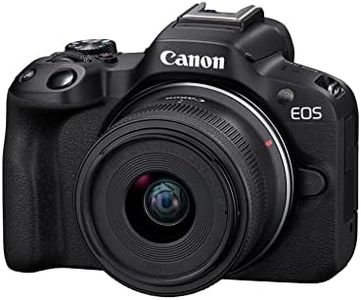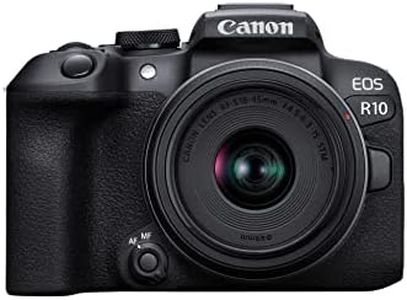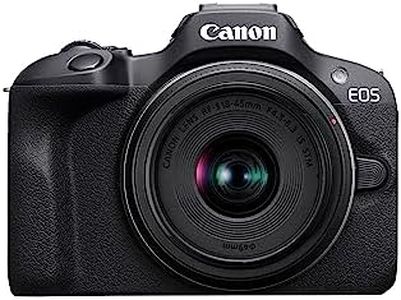We Use CookiesWe use cookies to enhance the security, performance,
functionality and for analytical and promotional activities. By continuing to browse this site you
are agreeing to our privacy policy
7 Best Canon Mirrorless Cameras
From leading brands and best sellers available on the web.Buying Guide for the Best Canon Mirrorless Cameras
When shopping for a Canon mirrorless camera, it’s important to start by thinking about how you plan to use the camera. Mirrorless systems are popular for their balance of quality and portability, making them great for travelers, hobbyists, and professionals alike. You'll want to consider features that match your photography style—like if you love fast action shots, detailed portraits, or creating beautiful video content. Knowing what matters most to you will help you focus on the right specifications and make a better choice.Sensor SizeSensor size refers to the physical dimensions of the sensor inside the camera that captures light and creates your image. A bigger sensor typically means better image quality, especially in low light, and more background blur in portraits. For Canon mirrorless cameras, the main sensor sizes are Full Frame and APS-C. Full Frame sensors are larger and usually found in higher-end models, offering excellent image quality and performance, great if you want the best results and often shoot in challenging lighting. APS-C sensors are a bit smaller and found in more compact or lightweight designs, which can make the camera easier to carry and still deliver great results, perfect for everyday shooting, travel, or beginners. To decide which is right for you, think about whether you prioritize image quality or a more portable setup.
MegapixelsMegapixels (MP) measure the resolution of your camera’s sensor, or how much detail it can capture. A higher megapixel count means your photos will contain more detail, which is great if you plan to make large prints or crop your images a lot. However, for most casual or social media uses, a moderate megapixel count is often enough and can even make photos easier to edit or store. Cameras today usually offer anything from around 20MP to 30MP or even higher. If you mainly share photos online or print small to medium sizes, 20-24MP is just right. Go higher if you need the extra detail for big prints or lots of cropping.
Autofocus SystemThe autofocus (AF) system determines how quickly and accurately the camera brings subjects into focus. Modern mirrorless cameras, including those from Canon, use a variety of autofocus points across the sensor. The more autofocus points, the better it can track moving subjects and focus precisely on specific parts of your scene. If you're photographing sports, kids, pets, or anything that moves, prioritize a camera with more advanced AF features and higher-point counts. If you mostly shoot still subjects, simpler AF systems will still serve you well.
Continuous Shooting SpeedContinuous shooting speed, often measured in frames per second (fps), tells you how many pictures your camera can take in rapid succession when you hold down the shutter button. This is very important for action, sports, or wildlife photography, where capturing just the right moment can make a big difference. Entry-level models might offer 5-7 fps, suitable for general use, while more advanced models reach 10 fps or more, ideal for capturing fast movement. If you do a lot of action photography, look for higher speeds; otherwise, moderate speeds are typically enough for everyday scenes.
Video CapabilitiesVideo capabilities cover features like resolution (such as 4K or Full HD), frame rates, and additional video-focused tools. If you want high-quality video for vlogging, YouTube, or filmmaking, you’ll want features like 4K recording, faster frame rates for slow motion, and good autofocus in video mode. Also, look for audio input options if you plan to use an external microphone. For those interested only in casual clips, most mirrorless cameras' standard video features will be just fine.
Lens CompatibilityLens compatibility refers to which lenses you can use with your camera. Canon mirrorless cameras typically use the RF (for full frame) or EF-M (for APS-C) lens mounts. More available lenses mean more creative options. If you already own Canon lenses from a DSLR, look for whether the camera supports adapters to use them. When buying, think about the types of photos you want to take—portraits, landscapes, wildlife—and check if there are lenses that fit your needs.
Size and WeightSize and weight affect how comfortable the camera is to carry around. Mirrorless cameras tend to be lighter and more compact than traditional DSLRs, but within the lineup, some are designed for portability while others offer a larger grip and more robust build. If you’re traveling or like to shoot for long periods, a smaller, lighter camera can be easier to manage. If you prefer a solid, stable grip and plan to use larger lenses, a slightly heavier camera might feel better in your hands.
